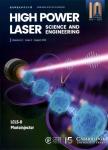Exploring novel target structures for manipulating relativistic laser–plasma interaction
Exploring novel target structures for manipulating relativistic laser–plasma interaction作者机构:physics DepartmentThe Ohio State UniversityColumbusOH 43210USA State Key Laboratory of High Field Laser PhysicsShanghai Institute of Optics and Fine MechanicsChinese Academy of SciencesShanghai 201800China Collaborative Innovation Center oflFSA(CICIFSA)Shanghai Jiao Tong UniversityShanghai 200240China Institut fur Theoretische PhysikⅠHeinrieh-Heine-Universitat Dusseldorf40225 DusseldorfGermany
出 版 物:《High Power Laser Science and Engineering》 (高功率激光科学与工程(英文版))
年 卷 期:2017年第5卷第2期
页 面:63-71页
核心收录:
学科分类:080901[工学-物理电子学] 07[理学] 0809[工学-电子科学与技术(可授工学、理学学位)] 08[工学] 080401[工学-精密仪器及机械] 0804[工学-仪器科学与技术] 070204[理学-等离子体物理] 0803[工学-光学工程] 0702[理学-物理学]
基 金:supported by the AFOSR Basic Research Initiative (BRI) under contract FA9550-14-1-0085 and allocations of computing time from the Ohio Supercomputing Center supported by DFG Trnsregio TR18 (Germany)
主 题:electron acceleration laser–plasma interaction micro-structured targets
摘 要:The improved laser-to-pedestal contrast ratio enabled by current high-power laser pulse cleaning techniques allows the fine features of the target survive before the main laser pulse arrives. We propose to introduce the nano-fabrication technologies into laser–plasma interaction to explore the novel effects of micro-structures. We found out that not only laser-driven particle sources but also the laser pulse itself can be manipulated by specifically designed micro-cylinder and-tube targets, respectively. The proposal was supported by full-3D particle-in-cell simulations and successful proofof-principle experiments for the first time. We believe this would open a way to manipulate relativistic laser–plasma interaction at the micro-size level.



